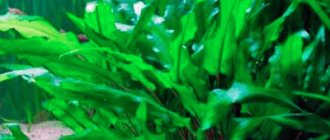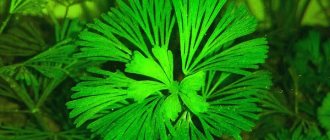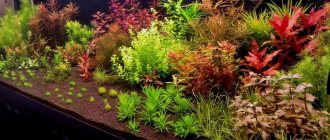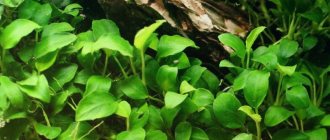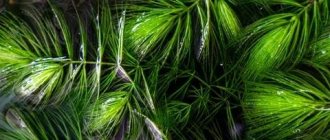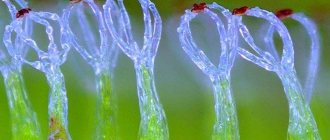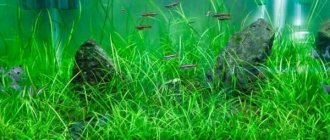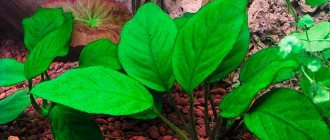Botanical description and natural habitat
The earliest description was given in 1853 by the Swede Carl Linnaeus, a natural scientist. Urut belongs to the genus Myriophyllum or “countless leaves”. He comes from South America from the shores of the Amazon. In Russia it can be found in the rivers of the European northern part. Today these plants are common on all continents except the Arctic. They prefer to inhabit reservoirs with fresh and almost stagnant water at a depth of 0.5 to 2 m.
The picturesque appearance has found application in decorating aquariums. Good conditions lead to the formation of dense openwork thickets in the water. The stem is colored in a variety of green or brown and red shades. In appearance it looks powerful and strong, in nature it bends with the flow, but in reality it is weak. There is practically no branching. The leaves are connected into a corolla of 3-5 pieces.
Color ranges from pale green to terracotta. Depends on environmental conditions: temperature, acidity, lighting, hardness and degree of pollution. Cirrus is a hydrophyte: it grows in the water column, partially rising above the surface. The leaves located below are different from the upper ones. The lower ones are large, soft, fluffy, and the upper ones are medium-sized and hard. The root system is practically undeveloped.
They are bred in aquariums for elegant decoration and enrichment of water with oxygen. With good development, you will get outlandish bushes that cast a bright green shadow.
Photo gallery of Cirrus:
Cirrus - aquarium plant
Cirrus (Myriophyllum) is a member of the Slatberry family. (Myriophyllum) Distributed almost everywhere, absent in cold areas and rare in Africa. In most cases, a plant rooted in the ground with an elongated, creeping stem in damp soil, and an erect stem under water, which produces shoots in the lower part. The leaf arrangement is whorled, alternate and opposite. The leaf blade is entire or pinnately dissected with thin long segments. Cirrus can be recommended to “revitalize” an aquarium. Perhaps only one species is suitable for this, known as pinnate spicatum. This graceful long-stemmed branching plant with a whitish stem and delicate, thin, feathery dark green leaves, forms delicate thread-like roots and requires planting in soil (preferably shallow) for good development. However, in general, it is unpretentious and easily begins to grow in a new place.
Brazilian pinnate (Myriophyllum brasiliense). Distributed in South and North America. An elegant, long-stemmed plant of light green color, widespread among aquarists. Forms dense thickets in the water column. The stem branches intensively. Under water, the leaf arrangement is whorled, sometimes with a pale reddish tip, leaves up to 4 cm long. Usually the leaves are bright green, short, hard, with a velvety sheen, consisting of 3-5 leaves of an annual shoot. Grows well in bright light. Water hardness does not matter. The water temperature in summer should be within 25 °C, and in winter - 15-20 °C. Brazilian pinnate is picky about lighting conditions. The light should be bright. With a lack of lighting, the cirrus becomes very elongated and its leaves lose their bright color.
The plant benefits from natural diffused light, but the plant must be protected from direct sunlight, as it is very afraid of algae fouling. For artificial lighting, incandescent lamps and LB-type fluorescent lamps can be used. The power of the latter should be 0.4 - 0.5 W per 1 liter of aquarium volume. The length of daylight that a pinnate plant needs can be determined by its behavior: when the plant has received enough light, it folds its leaves and the light should turn off after about 30 minutes. Cirrus is easily propagated by stem cuttings. Usually they are planted in a group, but they can be allowed to float in the water column. Strongly overgrown plant vines must be periodically shortened by removing the top. Then it is transplanted into the ground, deepening the lower whorl of leaves. A root system forms very quickly at the base of the leaves.
The cirrus is a decoration for the aquarium, an excellent refuge for fry and a substrate for spawning. The chemical composition of water can be in the range: KH 2-12°, pH 5.5-7.5. Scabratum pinnate (Myriophyllum scabratum). Places of distribution: eastern part of North America, Cuba. The stem branches intensively. Under water, the leaf arrangement is whorled (3-5 leaves), individual leaves are alternate. The leaf blade is dark green, pinnately dissected, up to 3 cm long. Maintenance conditions: water 18-24° C, KH 5-15°, pH 6.5-7.5; lighting 0.4 W/l. Red pinnate (Myriophyllum mattogrossense). Places of distribution: South America. Height up to 60 cm.
Under water, the leaf arrangement is whorled, with 5-7 pinnately dissected leaves up to 5 cm long. The stem and leaves are reddish to brown. Conditions: water 22-28° C, pH 5-12°, pH 6-7.2; lighting 0.4-0.5 W/l; does not tolerate pollution well. Grows 10 cm per week. Pinnate (Myriophyllum hippuroides). Places of distribution: eastern North America, Central America. Height up to 50 cm. The stem is moderately branched, reddish. Under water, the leaf arrangement is whorled, with 4-6 pinnately dissected leaves of olive green to reddish color, up to 3 cm long, the segments are slightly curved downwards. Conditions: water 16-25°C, KH up to 20°, pH 6.5-7.5; lighting 0.5-0.7 W/l. Grows 10 cm per week.
Whorled pinnate (Myriophyllum verticillatum). Places of distribution: Asia, Europe, North America and northern Africa. The stem is moderately branched. The leaf arrangement is whorled, with 5, rarely 3-4, pinnately dissected dark green leaves up to 4.5 cm long, the segments are slightly curved down. Conditions: water 17-22° C, temperature 5-10°, pH 7-8; lighting 0.4 W/l. In winter it dies, leaving overwintering buds.
Mr. Tail recommends: varieties
There are several popular species of Cirrus. They differ in the color of the leaves in the whorls and the height of the bush.
Variable flower
A wonderful plant (almost 1 m). Color: various shades of green. The leaf is divided into 10-16 small individual sections. The distance between the brushes is quite large. Prefers cold water.
Brazilian
Unpretentious and beautiful. The name is due to its growth in Brazil. Long, fleshy stems (30 cm). The leaves are bright green, they can rise above the surface, becoming bluish. They close at night. Feels great in any aquarium.
Variegated
In nature it reaches more than 1 m in height. Underwater leaves are light green, above-water leaves are darker.
Tail-shaped (hippuroides) or Hiproides
Large leaves forming extensive thickets. Very high water and air temperatures are undesirable. Serves as a shelter for fry. It grows very quickly (8 cm per week), so the fluid level is periodically raised. Usually several plants are planted together.
Whorled
Strong root system, so in nature it can grow in fast water. The leaves are rough, round, deeply dissected, dark green. It forms buds from which new plants emerge in the spring.
Chipped or tender Urut
It is found in clear, shallow bodies of water and can grow above the surface. The ambient temperature must be high. The feathery leaves (3 cm) from yellow-red to olive in color are arranged randomly. Due to their branching and random growth, they have proven themselves well in aquariums with viviparous fish.
Christmas tree or warrior
Suitable for cold aquariums of any size. A high level of water is required, it should not be hard. Soil - sand (4-5 cm). The height of the bush is up to 1.5 m. The leaves (5 cm) resemble Christmas tree needles from light green to bluish. Inflorescences rise above the surface for pollination. A bud is formed, which overwinters, sinking to the bottom. Gives growth in spring. An excellent refuge for small fish and a base for spawning. Can be food for many underwater inhabitants.
Spiky
Clear, calm, slightly salty water is required. Should be pinched for bushiness. Good substrate for fish breeding. Does not tolerate high temperatures or dirt. Whitish stem (20-60 cm). Dark green leaves. Grows quickly. It dies off in winter.
Matogrossky Red, red stem
The leaves are red to brown (reddish-golden) in color. Located opposite or alternately. Height up to 60 cm. If kept well under water, very small flowers even appear.
Recommended for experienced aquarists.
Matogros green
Red subspecies. Rarely found in nature. Low (up to 40 cm). Usually planted in a bunch (10-15 pcs.). Forms openwork light green laces, decorating the aquarium.
Roraima
Simple in content. It has a beautiful unusual appearance: brown leaves with an orange tint on a red stem. Water should completely cover the plant; add more as it grows. Usually planted near the back wall of the aquarium.
Proserpinacoides
Height up to 30 cm. Grows under and above water. The leaves are light green on the branches arranged in a herringbone pattern.
Guayana
A new species, rarely seen. Small plant, slow growing, ideal for small aquariums. Periodic haircuts form a head. Delicate, breaks easily, so the proximity of large fish is not advisable.
Scabratum
Height 50 cm. Light green plant. Additional nutrients and filtration are required.
Nodule, red
A very capricious and attractive plant (40 cm). The leaves are comparable to red-brown needles. The water is preferably soft. The color depends on the lighting: from yellow to golden brown. Planted instead of cabomba, hornwort.
Main types
Cirrus is a beautiful plant with long, straight stems that grows in freshwater bodies. The name of the genus to which pinnates belong is translated from Greek as “countless leaves.” It is also called urut or water yarrow.
Cirrus was first found in South America on the coastline of the Amazon River. Today they can be found in many freshwater bodies with slow currents, they grow at a depth of up to 1.5 m.
We recommend that you familiarize yourself with the ten best plants for an aquarium.
Due to their excellent decorative qualities, pinnates are used as decorations for aquariums, as they grow quickly, forming dense lacy thickets.
Cirrus Roraima
Roraima pinnate is most often planted in the background of the aquarium. The best combination is a group with other green plants.
This plant reaches a height of 50 cm and a width of 6 cm. It is important to consider that the plant cannot live outside of water, and therefore the aquarium must be higher than the maximum height of the cirrus.
Did you know? The cirrus was first described by the Swedish naturalist Carl Linnaeus in the 19th century.
This type of pinnate requires a minimal amount of effort for normal existence. For a full life, the water temperature in the aquarium should not fall below +22 ° C, and the plant needs good artificial lighting.
Matogros green
This species is a subspecies of the red pinnate. It is very difficult to find in the wild, the only places being Ecuador and Peru. The plant has finely dissected, salad-colored foliage. The pinnate plant is squat and grows only up to 40 cm.
It can be found in aquariums in the form of a dense group of 10–15 pieces. This species quickly grows into delicate light thickets and serves as a beautiful decoration for the aquarium against the backdrop of other plants and the entire underwater world.
For a full life, the plant needs intense light for 10 hours, otherwise its high decorative qualities will not appear. The soil in which the urut will be planted should be as nutritious as possible. Water temperature is within +22…+30 °C.
Matogrossky red
In its natural environment, red wateryarrow grows in South America. The plant is very demanding in terms of maintenance and is recommended for cultivation only by trained aquarists.
The pinnate plant grows to the same height as other representatives of this species. Its red leaves have a finely dissected structure and are collected in small bunches of 4 pieces. The length of one leaf can grow up to 5 cm.
The stems branch well and thus form dense thickets. Bright lighting and water with sufficient fertilizer cause the leaves to turn a reddish-golden color.
Important! Good maintenance conditions will ensure that yarrow can bloom; tiny flowers appear in the axils of the leaves, which are located under water.
Brazilian
In the wild, it lives in the southern United States and South America. Of all the other representatives of this species, the Brazilian is the most unpretentious and at the same time very beautiful. The plant is endowed with long and fleshy stems. The bush reaches a height of 30 cm. The leaves grow up to 4 cm and have a bright green color.
They are collected in bunches of 5 leaves. The rhizomes are weak, the roots are thread-like. For normal life, the water temperature should be within +18…+25 °C.
In good light, the leaves reach the surface of the water and even emerge from it. When darkness sets in, the leaves curl up and open again when the light is turned on.
Christmas tree
In nature, it lives in the clean and at the same time cold waters of rivers that flow in Chile, New Zealand, Argentina and the northern regions of Europe. They are easy to care for and at the same time produce huge amounts of oxygen.
This pinnate plant is called so due to its strongly dissected leaves with needles. These plants grow up to 1.5 m in height. The needles reach a size of 5 cm. The color of the “needles”, which are collected in bunches, ranges from light green to bluish.
Important! When inflorescences appear, they rise above the water for pollination, and then sink under the water, forming a wintering bud, which, after the onset of warming, gives rise to a new plant.
They create a dense background of emerald color, which is a good hiding place for small fish and a substrate for spawning. The water temperature should be within +18…+20 °C. This plant is used not only for beauty, but also as food for some types of fish.
Proserpinacoides
Like other members of this species, Pinnatea proserpinacoides is an elegant plant that, thanks to its long stems, creates dense thickets in the natural environment of rivers in Brazil and South America.
The stems are covered with twigs on which thin leaves of light green color are arranged in a herringbone pattern. Unlike its relatives, it can grow both under and above water. It grows up to 30 cm in height. For good growth, you need a large amount of light and a water temperature above +20 °C.
Guai'an
A new species of pinnate, which can rarely be found in aquariums today. It has a lush and very beautiful appearance, making it very popular in aquarium design. The leaves are bright green and densely spaced on the stem. The width of the shoots is up to 4 cm, and the length of the leaves is 2 cm.
Familiarize yourself with the features of keeping such aquarium plants as Anubias nana, Glossostigma, Hygrophila, Elodea, Echinodorus, Cabomba, Cryptocoryne, Limnobium, Ludwigia, Marsilia, Nayas, Nymphoides, Pistia, Hornwort, Rotala, Sagittaria, Salvinia, Cottonwort and Java moss.
These dimensions make it ideal for nano aquariums. Slow growth allows you to maintain the original appearance of the aquarium for a long time. In addition, it feels good in close proximity to other plants.
Cirrus loves warm water within +22...+26 °C. The water should be as clean as possible and well lit.
Scabratum
Under natural conditions it grows in swampy places, near the muddy shores of lakes in North America and Cuba. For good growth it needs a lot of nutrients.
The plant is completely covered with whorls, each containing up to 5 leaves 3 cm long. Their color is light green. The height reaches 50 cm. Good maintenance conditions lead to the formation of dense thickets. This type of cirrus intensively enriches the water with oxygen.
Did you know? The largest plant is the giant-sized water lily, which lives on the Amazon River. Its leaves reach 2 meters and can support a child.
The water temperature should be within +22 °C. Additionally, good water filtration is needed so that the plant does not die.
Aquarium Basics
Aquatic plants in an aquarium create biological balance, so they are important environmental parameters for the inhabitants.
The requirements for water are: warm, clean, without turbidity. It is advisable to renew by a quarter frequently. Development requires good lighting for a long time.
Cirrus is perfect for cultivation because it is undemanding in its maintenance and is a good neighbor for a number of algae, plants and fish. Its beautiful fluffy leaves harmonize perfectly with them. But despite this, there are a number of recommendations necessary for Uruti to live a full life:
- Water is neutral or slightly acidic. Hardness 6°. Dirt, sticking to the leaves, prevents nutrients from being absorbed, so filters are needed. Temperature +18...+28 °C, may vary slightly for a specific species.
- Good lighting. A deficiency will result in stretching and diminished coloring. Direct natural light is not desirable.
- Coarse sand as soil (3 cm) or container at the bottom.
- Additional fertilizing is not required, but its use will improve the quality of the plant.
- Many of the species require additional carbon dioxide to thrive.
Botanical description
Spica urut ( Myriophyllum spicatum
).
Botanical illustration from A. Masclet's book Atlas des plantes de France
, 1891
Uruti seeds
Annual or perennial herbaceous plants that grow completely submerged in water or slightly protrude from it (hydrophytes). There are rhizomes. The stems branch weakly. The elasticity of the stems allows the plants not to break, but only to bend under the pressure of the current and then return to their original position.
The main distinguishing feature of uruti is its leaves. They are feather-like, collected in whorls of 3-4. This distinguishes urut from other aquatic plants. Rarely are the leaves alternate. Heterophyllia occurs - on the same plant, the leaves that are outside the water are smaller and stiffer than those that are immersed in its thickness, in addition, their above-water leaves are not dissected.
Plants are dioecious or monoecious. In addition, urut has another unique property: it is the only plant immersed in water, whose generative buds protrude above the water. The inflorescences are thin, green and therefore inconspicuous. They contain 2-4 unisexual, less often bisexual, small flowers. Male and bisexual flowers have 2-8 stamens. In female and bisexual flowers there is a lower ovary, divided into 4 (rarely 2) compartments. There are 4 scars clearly visible on the ovary, as there is no style. Female flowers often lack petals.
From the editor: Names for female fish starting with the letter f
The fruit is a four-lobed schizocarp, each lobe contains one seed.
Reproduction and planting
Almost all species of Cirrus propagate by vegetative and seed methods. For cuttings, choose a healthy, strong plant. Having cut it off, it is placed in the ground for rooting.
There are several types of processes:
- Head. Obtained by cutting off the crown of the plant, up to the third epicotyl. The best option for planting.
- Shooting. Separated from the side branches or from the remaining part of the stem after the formation of the head. Length 3-4 internodes.
The cut is made with a sharp tool and the cutting is immediately planted in the ground. This is the easy way. You can use the advice of experienced aquarists, who act somewhat differently:
- First, the shoots are left to move freely on the surface for several weeks to form roots.
- Then a hole is formed in the ground, where a ball rolled from clay is placed. Then the cutting is placed and its regrown roots and the section up to the second tassel of leaves are covered with sand.
Economic importance and application
Aquarium
Some species - brazilian urut, whorled urut, alternate-flowered urut, reed-like urut, variegated urut, caudal urut - are used as aquarium plants. Nurseries that sell urut grow it in damp soil and high humidity. Plants grown in this way grow better and form shoots more abundantly than those grown in the water column. However, seedlings grown in water are also sold. Plants grown outside of water should adapt to it gradually. To do this, you need to plant the seedlings in nutrient-rich soil and increase the water level by 1 cm every day until it reaches the maximum water level in the aquarium. With this method, plants grow very quickly.
From the editor: Sera bakto tabs - sera bakto tabs
Invasiveness
Three species (Myriophyllum aquaticum, Myriophyllum heterophyllum, and Myriophyllum spicatum) infest lakes, natural waterways, and irrigation canals in North America. The Tennessee River Valley Water Authority discovered urt in its waters in the 1960s. It did not recognize the significant value of uruti as a food plant or raw material for industry and began to fight it with chemicals and lowering water levels. The water lilies Nelumbo lutea are supposed to deprive the urut of sunlight. Populations of the widespread invasive species Myriophyllum spicatum are also controlled by herbicides containing diquat dibromide
Control can also be achieved through gentle mechanical action, but this will only lead to the division of the plant into parts, which will then develop into individual plants. In 2007, Professor Sallie Sheldon of Middlebury College reported that the aquatic weevil Euhrychiopsis lecontei, which feeds exclusively on urticaria, is an effective defense against it.
Possible problems
Proper care of the plant ensures its growth and development. Violation of one of the habitat requirements can create problems and lead to the death of the Cirrus:
- Exposure to direct sunlight will encourage the rapid proliferation of brown algae. They will interfere with the correct formation of Uruti, reduce its attractiveness and can strangle the plant.
- Lack of light negatively affects development. The plant is exhausted and fades. Leaves fall.
- This is an excellent treat for some species of fish and snails, which readily eat varieties with small leaves.
Varieties of freshwater crops
The plant takes root in warm and cool water. Cirrus, the species of which differ in color, is distributed almost throughout the globe.
- Variable flowering. The bush is found in the rivers of Spain and America. If it grows in natural conditions, it reaches a height of 1.3 m. The whorls have 5 leaves, the color of which varies from light to dark green. Cirrus varifolia prefers cold water. For full photosynthesis, the temperature must be no less than 18 and no more than 20 degrees.
- Brazilian. This species grows in the southern United States. Its height does not exceed 30 cm. The plant has an underdeveloped root system consisting of thin shoots. Brazilian water milfoil feels good in water with a temperature of + 23 degrees.
- Reed-like. The shrub grows in the rivers of Chile and Mexico. Its average height is 70 cm. The whorls have four leaves of green or bluish color. The exotic culture takes root in warm water, the temperature should be about 25 degrees.
- Variegated. A distinctive feature of the plant is its massive roots. It can be found in the rivers of North America. Under natural conditions, aquatic yarrow reaches a height of 1 m. Its stems are thin and elongated. Photosynthesis occurs at a temperature of plus 22 degrees.
- It flaunts in the ponds of North America, grows 1.5 - 2 m. The leaves of this species are dark, forming small whorls. The plant loves water whose temperature does not exceed + 20 degrees.
- Chapped. This variety is called tender urutya. It takes root in swampy areas and is common in Mexico and Cuba. The plant has a stem 50 cm high. The whorls fit tightly to each other and include 4 leaves. Exotic culture develops well at a temperature of + 23 degrees.
- Christmas tree. It grows in cold rivers of Chile and Mexico. The herringbone pinnate can be seen in northern Europe. It is distinguished by a hollow stem 1.5 m high. The leaves resemble needles, which is why the culture received its characteristic name. The recommended temperature for growing in an aquarium is +21 degrees.
- Redstem. The birthplace of this culture is sunny Cuba. It prefers to grow in rivers with crystal clear water. Red-stemmed pinnate loves warmth, but you can keep it in the same aquarium with cold-resistant plants. It is recommended to place it in water at a temperature of at least 25 degrees.
- Green. It produces beautiful flowers that are shaped like violets. Green pinnate has many varieties of white, red and blue colors. Feels comfortable in water at a temperature of +26 degrees.
Editor's note: A 132-year-old lobster was released into the wild in America
There are many types of freshwater crops
Conditions of detention
Cirrus is quite demanding in terms of maintenance: it needs bright lighting, clean water; Sometimes it is advisable to feed the plant with fertilizer.
For comfortable growth, a low, 30 cm, aquarium is required. This is due to the high requirement for light: the high altitude of the water column contributes to poor light penetration to the lower tier. Lack of light will immediately affect the plant - the lower whorls will shed dead leaves. For this reason, plantings should not be crowded - by shading each other, they will lose leaves and may disappear themselves. Lighting is produced with fluorescent lamps from 0.5 W/l. Flora Phillips lamps, which have a predominant red component, are suitable for this purpose.
When using bright lighting, you need to be extremely careful, as you can cause the growth of unwanted algae, which will happily settle on the cirrus. Without receiving enough light because of them, the plant will wither; By increasing the light intensity, you can accelerate the growth of parasitic algae. Preparations for purifying water from unwanted vegetation will come to the rescue.
At the bottom of the aquarium there should be fine soil of medium silt: pebbles, river sand. Frequent washing and cleaning of the soil should not be carried out - this is a good nutrient medium for red cirrus.
The temperature regime for red pinnate should vary between +20 °C. and +26 °C. The water required is clean, fresh, settled, with a hardness of no more than 15°dH. The maximum permissible acidity is pH 6.5.
The plant does not tolerate turbidity - if it settles on thin needles, it will worsen photosynthesis. The cirrus, whose living conditions are already not ideal in artificial reservoirs, will lose the necessary nutrition and die.
A filter is required to purify water from suspended particles. The plant responds well to the enrichment of the aquatic environment with carbon dioxide: the aquarium must be equipped with a CO2 generator device.
The cirrus is demanding in terms of nutrition and is a little capricious: lacking iron, it will never turn into the bright red color for which it is so valued. In a network of stores selling pet supplies, you can purchase the necessary fertilizer containing iron. There, if necessary, you can buy other microelements for a luxurious appearance and proper growth of higher underwater plants.
Not all aquarists trust the chemical industry and feed the plant in their own way: a small lump of clay, preferably red, is placed under the bush. This simple technique can prevent the hunger of the most demanding plant. Their experience can be used by anyone who cannot access store goods due to high prices and inaccessibility of the stores themselves.
